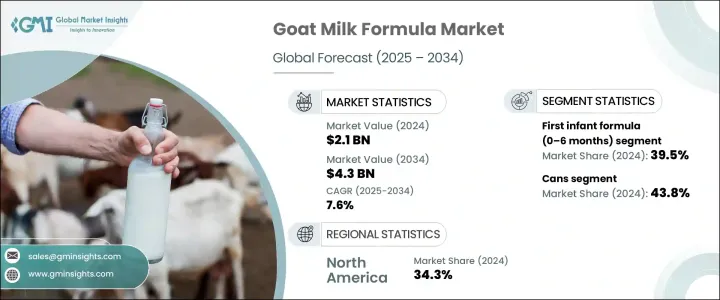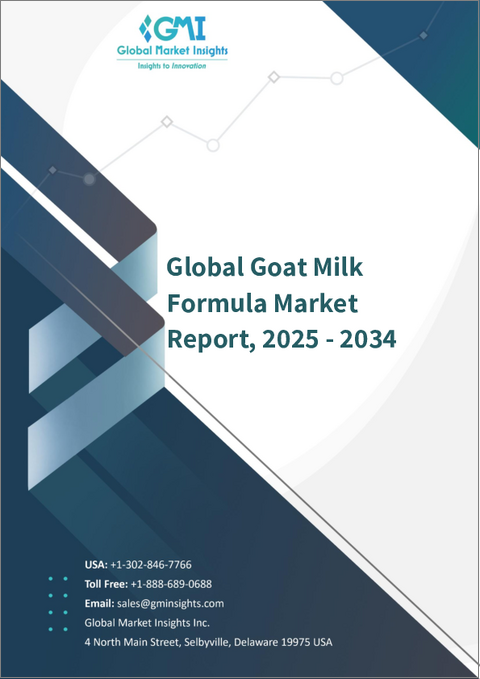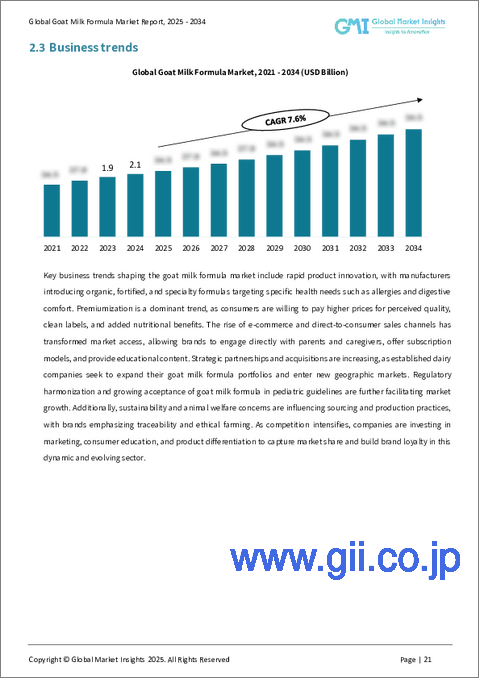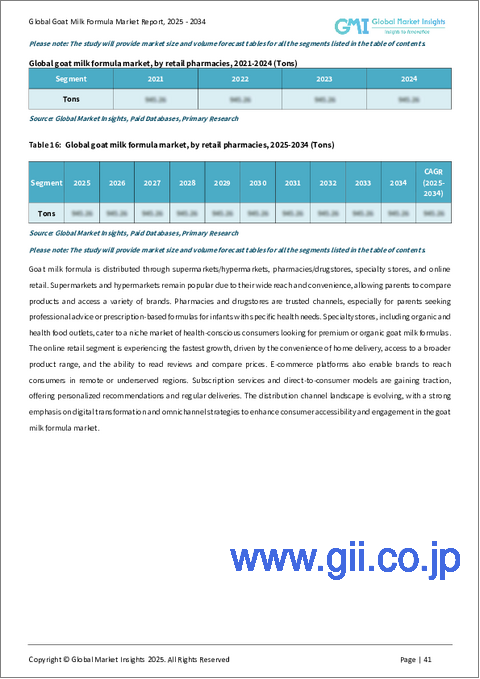|
|
市場調査レポート
商品コード
1740946
ヤギ乳調製粉乳の市場機会、成長促進要因、産業動向分析、2025年~2034年予測Goat Milk Formula Market Opportunity, Growth Drivers, Industry Trend Analysis, and Forecast 2025 - 2034 |
||||||
カスタマイズ可能
|
|||||||
| ヤギ乳調製粉乳の市場機会、成長促進要因、産業動向分析、2025年~2034年予測 |
|
出版日: 2025年04月28日
発行: Global Market Insights Inc.
ページ情報: 英文 220 Pages
納期: 2~3営業日
|
全表示
- 概要
- 目次
世界のヤギ乳調製粉乳市場は、2024年に21億米ドルとなり、消化しやすさ、牛乳アレルギーや乳糖不耐症の乳児に適しているなど、ヤギ乳の健康上の利点に対する消費者の意識が高まっていることが背景に、7.6%のCAGRで成長し、2034年までには43億米ドルに達すると予測されています。
さらに、親が子供の食事に何を入れるかについてますます気を配るようになるにつれ、天然の非遺伝子組み換え原材料から作られたヤギ乳調製粉乳への選好が高まり続けています。ブランドは、シンプルな成分表、倫理的な調達方法、持続可能性の証明などを強調するよう求められています。

同時に、eコマース・プラットフォームとデジタル小売の急成長により、特に新興市場において、プレミアム調製粉乳ブランドへの消費者のアクセスが広がっています。アジア太平洋では、食生活の変化、都市化、健康意識の高まりが需要の急増を後押ししています。乳糖過敏症の割合が高く、高品質な栄養への投資意欲が高まっていることから、インドや中国のような人口密度の高い国の家庭が、このセグメントの持続的成長を牽引しています。
| 市場範囲 | |
|---|---|
| 開始年 | 2024年 |
| 予測年 | 2025年~2034年 |
| 開始金額 | 21億米ドル |
| 予測金額 | 43億米ドル |
| CAGR | 7.6% |
ヤギ乳調製粉乳市場は製品タイプ別に乳児用調製粉乳(0~6ヵ月)、フォローアップミルク(6~12ヵ月)、成長期用調製粉乳(1~3歳)に区分されます。2024年、乳児用調製粉乳は39.5%のシェアを獲得しましたが、これは主に消化器系が敏感な新生児に対する消化性と適合性に関する保護者の意識の高まりに後押しされたものです。多くの親は、ヤギ乳は牛乳よりもやさしく吸収されやすい代替品であると認識しており、乳児の初期段階には好ましい選択肢となっています。その利点にもかかわらず、この分野は価格面での課題に直面しています。ヤギ乳調製粉乳は通常、従来の選択肢よりも高価であるため、多くの家庭にとって価格の障壁となっています。
パッケージでは、缶、小袋、ボトル、カートンがあります。缶は2024年に43.8%のシェアでこのセグメントをリードし、CAGR6.6%で成長しながら力強い勢いを維持すると予想されます。その耐久性、再密封性、高級感のあるプレゼンテーションにより、缶は消費者や小売業者に高く支持されています。ブランドは、製品の栄養価について消費者を教育するために、戦略的ポジショニングと情報提供マーケティングを活用しています。また、環境意識の高い購買層にアピールするため、リサイクル可能なパッケージングや倫理的な調達をアピールするブランドによって、持続可能性に関するメッセージも役立っています。
北米のヤギ乳調製粉乳市場は2024年に34.3%のシェアを占めました。このポジションを支えているのは、先進的な小売インフラ、特殊製品の普及、代替乳製品ソリューションを促進する政府の支援的枠組みなど、いくつかの要因です。乳糖不耐症や牛乳タンパク質に関連するアレルギーが乳幼児の間で増加していることが、ヤギ乳ベースの代替乳の需要を大幅に押し上げています。保護者は、より安全で消化が良いと認識される調製粉乳を選ぶ傾向が強まっており、各ブランドが都市部や郊外で市場浸透を深めるのに役立っています。
世界のヤギ乳調製粉乳市場の主要企業には、Holle Baby Food AG、Unica Global B.V.、Ausnutria Dairy Corporation Ltd、Nannycare Ltd、Danone SAなどがあります。これらの企業は、製品のイノベーション、品質基準、流通ネットワーク、消費者教育イニシアチブに注力し、市場での地位を強化しています。ヤギ乳調製粉乳市場の企業は、市場での存在感を高めるためにいくつかの戦略を採用しています。これには、さまざまな年齢層や栄養要件に対応するための製品ポートフォリオの拡大、研究開発による製品の品質向上、製品の入手しやすさを高めるための流通網の改善などが含まれます。さらに、環境意識の高い消費者にアピールするため、企業は持続可能性と倫理的慣行に注力しています。
目次
第1章 調査手法と範囲
第2章 エグゼクティブサマリー
第3章 業界考察
- 業界エコシステム分析
- バリューチェーンに影響を与える要因
- 利益率分析
- ディスラプション
- 将来の展望
- 製造業者
- 販売代理店
- 貿易への影響
- 貿易量の混乱
- 報復措置
- 業界への影響
- 供給側の影響(原材料)
- 主要原材料の価格変動
- サプライチェーン再構築
- 生産コストへの影響
- 供給側の影響(原材料)
- 需要側の影響(販売価格)
- 最終市場への価格伝達
- 市場シェアの動向
- 消費者の反応パターン
- 影響を受ける主要企業
- 戦略的業界対応
- サプライチェーンの再構成
- 価格設定と製品戦略
- 政策関与
- 展望と今後の検討事項
- サプライヤーの情勢
- 利益率分析
- 主なニュースと取り組み
- 規制情勢
- 影響要因
- 成長促進要因
- デジタルの利便性とEコマースの成長
- 持続可能性を重視したパッケージ需要
- 生産と革新における技術の進歩
- 業界の潜在的リスク・課題
- 低い消費者の認知度
- 厳格な規制枠組み
- 成長促進要因
- 成長可能性分析
- ポーター分析
- PESTEL分析
第4章 競合情勢
- イントロダクション
- 企業の市場シェア分析
- 競合ポジショニングマトリックス
- 戦略的展望マトリックス
第5章 市場推計・予測:タイプ別、2021年~2034年
- 主要動向
- 最初の乳児用調製粉乳(0~6ヶ月)
- フォローアップ調製粉乳(6~12か月)
- 成長期用調製粉乳(1~3歳)
第6章 市場推計・予測:包装別、2021年~2034年
- 主要動向
- 缶
- サシェ
- ボトル
- カートン
第7章 市場推計・予測:流通チャネル別、2021年~2034年
- 主要動向
- スーパーマーケット・ハイパーマーケット
- 薬局・ドラッグストア
- オンライン小売
- 専門店
- コンビニエンスストア
第8章 市場推計・予測:地域別、2021年~2034年
- 主要動向
- 北米
- 米国
- カナダ
- 欧州
- ドイツ
- 英国
- フランス
- スペイン
- イタリア
- オランダ
- アジア太平洋
- 中国
- インド
- 日本
- オーストラリア
- 韓国
- ラテンアメリカ
- ブラジル
- メキシコ
- アルゼンチン
- 中東・アフリカ
- サウジアラビア
- 南アフリカ
- アラブ首長国連邦
第9章 企業プロファイル
- Dana Dairy Group
- Ausnutria BV
- Unica Global BV
- Nannycare Ltd
- Danone
- Little Bundle
- Danalac
- Holle Baby Food AG
The Global Goat Milk Formula Market was valued at USD 2.1 billion in 2024 and is estimated to grow at a CAGR of 7.6% to reach USD 4.3 billion by 2034, driven by increasing consumer awareness of the health benefits of goat milk, such as its easier digestibility and suitability for infants with cow milk allergies or lactose intolerance. Moreover, as parents become increasingly mindful of what goes into their children's diets, the preference for goat milk formula made from natural, non-GMO ingredients continues to gain traction. Clean-label transparency is now a key factor in purchasing decisions, prompting brands to highlight simple ingredient lists, ethical sourcing practices, and sustainability credentials.

At the same time, the rapid growth of e-commerce platforms and digital retail has widened consumer access to premium formula brands, especially in emerging markets. In the Asia Pacific region, shifting dietary habits, urbanization, and heightened health awareness are fueling a surge in demand. With high rates of lactose sensitivity and an increasing willingness to invest in high-quality nutrition, families in densely populated nations like India and China are driving sustained growth in this segment.
| Market Scope | |
|---|---|
| Start Year | 2024 |
| Forecast Year | 2025-2034 |
| Start Value | $2.1 Billion |
| Forecast Value | $4.3 Billion |
| CAGR | 7.6% |
The goat milk formula market is segmented by product type into first infant formula (0-6 months), follow-on formula (6-12 months), and growing-up formula (1-3 years). In 2024, the first infant formula captured a 39.5% share, primarily fueled by rising parental awareness regarding its digestibility and suitability for newborns with sensitive digestive systems. Many parents perceive goat milk as a gentler and more easily absorbed alternative to cow's milk, making it a preferred choice for infants in the early stages. Despite its advantages, the segment faces pricing challenges, as goat milk formulas are typically more expensive than conventional options, creating a price barrier for many families.
On the packaging front, formats include cans, sachets, bottles, and cartons. Cans led the segment with a 43.8% share in 2024 and are anticipated to maintain strong momentum, growing at a CAGR of 6.6%. Their durability, resealability, and premium presentation make them highly favored by consumers and retailers. Brands leverage strategic positioning and informative marketing to educate consumers about the product's nutritional value. Sustainability messaging is also helping with brands showcasing recyclable packaging and ethical sourcing to appeal to eco-conscious buyers.
North America Goat Milk Formula Market held a 34.3% share in 2024. Several factors support this position, including an advanced retail infrastructure, widespread availability of specialized products, and supportive government frameworks that promote alternative dairy solutions. Rising incidences of lactose intolerance and allergies related to cow's milk proteins among infants have significantly boosted demand for goat milk-based alternatives. Parents are increasingly opting for formula options perceived as safer and more digestible, helping brands gain deeper market penetration in urban and suburban areas.
Key players in the Global Goat Milk Formula Market include Holle Baby Food AG, Unica Global B.V., Ausnutria Dairy Corporation Ltd, Nannycare Ltd, and Danone SA. These companies focus on product innovation, quality standards, distribution networks, and consumer education initiatives to strengthen their market positions. Companies in the goat milk formula market are adopting several strategies to boost their market presence. These include expanding product portfolios to cater to different age groups and nutritional requirements, enhancing product quality through research and development, and improving distribution networks to increase product accessibility. Additionally, companies are focusing on sustainability and ethical practices to appeal to environmentally conscious consumers.
Table of Contents
Chapter 1 Methodology & Scope
- 1.1 Market scope & definition
- 1.2 Base estimates & calculations
- 1.3 Forecast calculation
- 1.4 Data sources
- 1.4.1 Primary
- 1.4.2 Secondary
- 1.4.2.1 Paid sources
- 1.4.2.2 Public sources
- 1.5 Primary research and validation
- 1.5.1 Primary sources
- 1.5.2 Data mining sources
Chapter 2 Executive Summary
- 2.1 Industry synopsis, 2021-2034
Chapter 3 Industry Insights
- 3.1 Industry ecosystem analysis
- 3.1.1 Factor affecting the value chain
- 3.1.2 Profit margin analysis
- 3.1.3 Disruptions
- 3.1.4 Future outlook
- 3.1.5 Manufacturers
- 3.1.6 Distributors
- 3.1.7 Impact on trade
- 3.1.8 Trade volume disruptions
- 3.2 Retaliatory Measures
- 3.3 Impact on the Industry
- 3.3.1 Supply-Side Impact (Raw Materials)
- 3.3.1.1 Price Volatility in Key Materials
- 3.3.1.2 Supply Chain Restructuring
- 3.3.1.3 Production Cost Implications
- 3.3.1 Supply-Side Impact (Raw Materials)
- 3.4 Demand-Side Impact (Selling Price)
- 3.4.1 Price Transmission to End Markets
- 3.4.2 Market Share Dynamics
- 3.4.3 Consumer Response Patterns
- 3.5 Key Companies Impacted
- 3.6 Strategic Industry Responses
- 3.6.1 Supply Chain Reconfiguration
- 3.6.2 Pricing and Product Strategies
- 3.6.3 Policy Engagement
- 3.7 Outlook and Future Considerations
- 3.8 Supplier landscape
- 3.9 Profit margin analysis
- 3.10 Key news & initiatives
- 3.11 Regulatory landscape
- 3.12 Impact forces
- 3.12.1 Growth drivers
- 3.12.1.1 Digital convenience and E-commerce growth
- 3.12.1.2 Sustainability-driven packaging demand
- 3.12.1.3 Technological advancements in production and innovation
- 3.12.2 Industry pitfalls & challenges
- 3.12.2.1 Limited consumer awareness
- 3.12.2.2 Strict regulatory frameworks
- 3.12.1 Growth drivers
- 3.13 Growth potential analysis
- 3.14 Porter's analysis
- 3.15 PESTEL analysis
Chapter 4 Competitive Landscape, 2024
- 4.1 Introduction
- 4.2 Company market share analysis
- 4.3 Competitive positioning matrix
- 4.4 Strategic outlook matrix
Chapter 5 Market Estimates and Forecast, By Type, 2021 - 2034 (USD Billion) (Kilo Tons)
- 5.1 Key trends
- 5.2 First infant formula (0–6 months)
- 5.3 Follow-on formula (6–12 months)
- 5.4 Growing-up formula (1–3 years)
Chapter 6 Market Estimates and Forecast, By Packaging, 2021 - 2034 (USD Billion) (Kilo Tons)
- 6.1 Key trends
- 6.2 Cans
- 6.3 Sachets
- 6.4 Bottles
- 6.5 Cartons
Chapter 7 Market Estimates and Forecast, By Distribution Channel, 2021 - 2034 (USD Billion) (Kilo Tons)
- 7.1 Key trends
- 7.2 Supermarkets & Hypermarkets
- 7.3 Pharmacies & Drugstores
- 7.4 Online retail
- 7.5 Specialty stores
- 7.6 Convenience stores
Chapter 8 Market Estimates and Forecast, By Region, 2021 - 2034 (USD Billion) (Kilo Tons)
- 8.1 Key trends
- 8.2 North America
- 8.2.1 U.S.
- 8.2.2 Canada
- 8.3 Europe
- 8.3.1 Germany
- 8.3.2 UK
- 8.3.3 France
- 8.3.4 Spain
- 8.3.5 Italy
- 8.3.6 Netherlands
- 8.4 Asia Pacific
- 8.4.1 China
- 8.4.2 India
- 8.4.3 Japan
- 8.4.4 Australia
- 8.4.5 South Korea
- 8.5 Latin America
- 8.5.1 Brazil
- 8.5.2 Mexico
- 8.5.3 Argentina
- 8.6 Middle East and Africa
- 8.6.1 Saudi Arabia
- 8.6.2 South Africa
- 8.6.3 UAE
Chapter 9 Company Profiles
- 9.1 Dana Dairy Group
- 9.2 Ausnutria BV
- 9.3 Unica Global BV
- 9.4 Nannycare Ltd
- 9.5 Danone
- 9.6 Little Bundle
- 9.7 Danalac
- 9.8 Holle Baby Food AG





